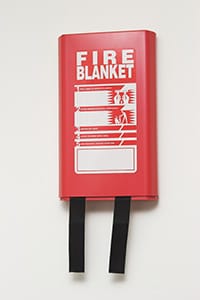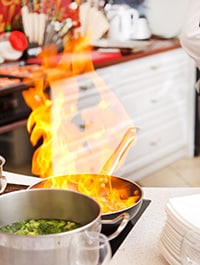The importance of a good quality fire blanket
 Blankets. Something that seems to have gone out of fashion over the years with the advent of duvets and quilts, however there may be one lurking in a kitchen near you!
Blankets. Something that seems to have gone out of fashion over the years with the advent of duvets and quilts, however there may be one lurking in a kitchen near you!
We have been testing fire blankets to the BSI Kitemark™ for 25 years. Their intended use is for small fires involving cooking oils (Class F), although there are other recognized applications such as clothing fires and small contained fires.
What’s it made of?
Fire blankets are usually woven fibreglass material, sometimes with a silicone based fire retardant coating. The use of a coating by a manufacturer often depends on the weave of the fibres and it can be quite scientific.
How to store your blanket
The blankets usually come in quick release suitably labelled containers, and should be stored in a strategic location where they can be pulled out easily in an emergency. They are single use and cannot be cleaned or repaired once used.
Fire blanket standards and testing
The current standard for fire blankets is BS EN 1869:1997 and this covers a variety of sizes, usually square, from 1.0m x 1.0m to a maximum of 1.8m x 1.8m, although some rectangular blankets are accepted too.
To test the blanket, we usually take the smallest of the range (the material should be the same no matter the size) and test against a standard fire. If the smallest blanket can smother and extinguish the fire, a larger blanket of the same material should be capable of doing so as well.
The ‘standard’ fire itself is 3 litres of cooking oil at self-ignition temperature (around 350˚C – 370˚C) which is much stronger than you would have in the average domestic environment. The smoke produced, as the heat builds up in the oil, is pungent and profuse, and it’s hoped that a smoke detector will have picked up the problem long before the oil ignites.
How to use your blanket
 If a fire should start, turn the heat off and then release your blanket by pulling it from its container using the attached tabs or handles. The blanket should then be gripped according to instructions and laid across the top of the pan to cover the burning material completely. As the blanket extinguishes the fire by cutting off oxygen from the fire, it should be left in place and not touched until the pan and oil has cooled, as there’s a risk of re-ignition.
If a fire should start, turn the heat off and then release your blanket by pulling it from its container using the attached tabs or handles. The blanket should then be gripped according to instructions and laid across the top of the pan to cover the burning material completely. As the blanket extinguishes the fire by cutting off oxygen from the fire, it should be left in place and not touched until the pan and oil has cooled, as there’s a risk of re-ignition.
Checking your blanket
Blankets can sit unused for many years and should be inspected by removing and checking for damage. It’s important to refold as per the instructions because introducing new folds may reduce its effectiveness. There should be guidance on replacing the blanket by the manufacturer – as a guide the industry recommends replacing after seven years.
Make a good purchase
As with any safety equipment, care should be taken to avoid fake products. The usual tell- tale signs are misspelt labels and references to incorrect standards or BSI Kitemark numbers. Having witnessed a number of fire tests, I’m certain I would want a genuine fire blanket with a BSI Kitemark on it to hand if needed and I would recommend you do the same.
Read more about BSI fire services >
